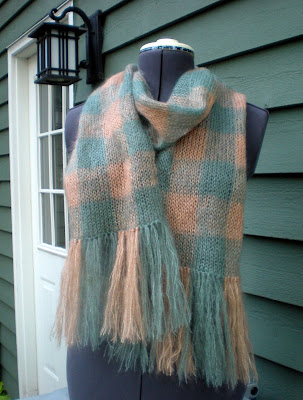
The very last individual technique for creating a plaid-look fabric with knitting is knit-weave. This falls into the category of embellishing because the fabric is first knitted and then yarn is woven across the surface to create the plaid.
 |
| #26 Cloche with Plaid Band by Franklin Habit from Vogue Knitting Winter 2014/15 |
The most popular base fabric for this technique is garter stitch. The purl bumps of the garter ridges are easy to follow for your weaving pattern. Also, by knitting horizontal stripes into the knitting, the weaving need only occur in the vertical direction.
 |
| Elementary Vest by Melissa Wehrle from Interweave Knits Fall 2010 |
 |
| Close up of Elementary Vest |
Stockinette stitch makes a poor base for this technique. The problem is that while the horizontal strands will lay nicely across the stitches, the vertical stripes want to sink down into it. In the Elementary Vest, the crossing lines in the center of the boxes always have the vertical stripe on top of the horizontal to keep it up off the surface. However, if you look hard at the close up of the knitted fabric, you will see that some of the vertical stripes connecting boxes have disappeared.
With multiple layers of yarn, especially when worked on a garter base, knit-weave creates a very thick fabric. This makes it a poor choice for most garments, unless it is worked very, very loosely. One of my favorite vintage plaid designs, gets around this by working in mohair. The fabric is knit at a loose gauge with the fuzz of the mohair fiber filling in the gaps.
In the last of our plaid series we'll look at combinations of techniques.
In the last of our plaid series we'll look at combinations of techniques.



















